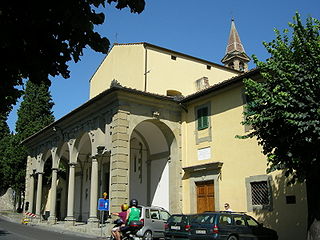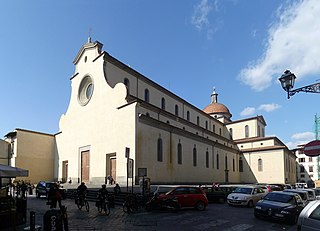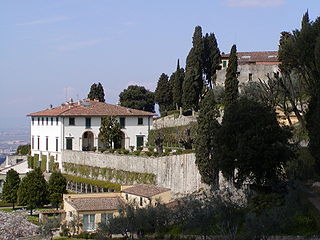 W
WThe Convent of San Domenico is a Dominican convent in Fiesole, Italy, situated between the hill of Fiesole and the suburbs of Florence. It was founded in 1406 and completed in 1435 on the initiative of Giovanni Dominici and the bishop of Fiesole, Jacopo Altoviti, both of them friars at the Basilica of Santa Maria Novella in Florence.
 W
WFlorence Cathedral, formally the Cattedrale di Santa Maria del Fiore, is the cathedral of Florence, Italy. It was begun in 1296 in the Gothic style to a design of Arnolfo di Cambio and was structurally completed by 1436, with the dome engineered by Filippo Brunelleschi. The exterior of the basilica is faced with polychrome marble panels in various shades of green and pink, bordered by white, and has an elaborate 19th-century Gothic Revival façade by Emilio De Fabris.
 W
WMonastero delle Murate is a former Benedictine convent on Via Ghibellina in Florence, Italy. For about a hundred years, from 1883 to 1985, it was the men's prison in Florence, after which the detainees were transferred to Sollicciano and other facilities. Since the 21st century, it has served as a restaurant and meeting places, with additional apartments, bars, restaurants and shops. The religious community dates to 1370 when 12 women became voluntarily reclusive in a shack by the second pillar of the Ponte Rubaconte, praying and living on alms in extremely difficult conditions. Given the growth in the number of sisters, in 1424, Giovanni de 'Benci, who lived nearby, financed the construction of a new, larger monastery near the walls, called the Most Holy Annunciation and St. Catherine. The monastery was renovated and expanded for the first time in 1471, following a fire, and then in 1571, after a flood. Supporters included Lorenzo de' Medici. Also in 1509 Caterina Sforza was buried in the monastery.
 W
WMonte delle doti was a public fund established by the government of the Republic of Florence in 1425. Its purpose was to provide suitable dowries to Florentine brides.
 W
WThe Ospedale degli Innocenti is a historic building in Florence, Italy. It was designed by Filippo Brunelleschi, who received the commission in 1419 from the Arte della Seta. It was originally a children's orphanage. It is regarded as a notable example of early Italian Renaissance architecture. The hospital, which features a nine bay loggia facing the Piazza SS. Annunziata, was built and managed by the "Arte della Seta" or Silk Guild of Florence. That guild was one of the wealthiest in the city and, like most guilds, took upon itself philanthropic duties. Today the building houses a small museum of Renaissance art with works by Luca della Robbia, Sandro Botticelli, Piero di Cosimo and an Adoration of the Magi by Domenico Ghirlandaio.
 W
WPalazzo Antinori is a Renaissance palace located at the north end of Via de' Tornabuoni, where it makes an odd corner with Via dei Pecori, Via del Trebbio, and converts into Via dei Rondinelli, in Florence, region of Tuscany, Italy.
 W
WThe Palazzo Medici, also called the Palazzo Medici Riccardi after the later family that acquired and expanded it, is a Renaissance palace located in Florence, Italy. It is the seat of the Metropolitan City of Florence and a museum.
 W
WSan Marco is a religious complex in Florence, Italy. It comprises a church and a convent. The convent, which is now the Museo Nazionale di San Marco, has three claims to fame. During the 15th century it was home to two famous Dominicans, the painter Fra Angelico and the preacher Girolamo Savonarola. Also housed at the convent is a famous collection of manuscripts in a library built by Michelozzo.
 W
WThe Basilica di Santo Spirito is a church in Florence, Italy. Usually referred to simply as Santo Spirito, it is located in the Oltrarno quarter, facing the square with the same name. The interior of the building – internal length 97 meters – is one of the preeminent examples of Renaissance architecture.
 W
WThe Villa Medici is a patrician villa in Fiesole, Tuscany, Italy, the fourth oldest of the villas built for the Medici family. It was built between 1451 and 1457. It is part of the UNESCO World Heritage Site inscribed as Medici Villas and Gardens in Tuscany.